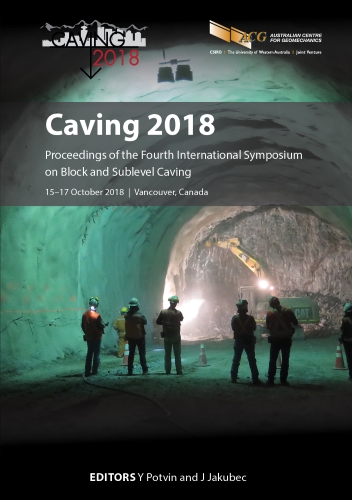Palabora Lift 1 block cave: understanding the grade behaviour

|
Authors: Diering, T; Ngidi, SN; Bezuidenhout, JJ; Paetzold, HD |
DOI https://doi.org/10.36487/ACG_rep/1815_04_Diering
Cite As:
Diering, T, Ngidi, SN, Bezuidenhout, JJ & Paetzold, HD 2018, 'Palabora Lift 1 block cave: understanding the grade behaviour', in Y Potvin & J Jakubec (eds), Caving 2018: Proceedings of the Fourth International Symposium on Block and Sublevel Caving, Australian Centre for Geomechanics, Perth, pp. 91-106, https://doi.org/10.36487/ACG_rep/1815_04_Diering
Abstract:
Palabora Mining Company commenced mining of the Lift 1 block cave in 2001. Lift 1 is now nearing completion, and this paper will discuss the challenges around the reconciliation and forecasting of grades during the life of Lift 1. Particular emphasis will be placed on the impact of the open pit failure which took place in 2004 and its impact on the grades later on in Lift 1. The paper will look at the different caving mechanisms which have contributed to, and impacted on, the recovered metal from the block cave. It will also look at how the cave management was impacted by the coarse fragmentation of the cave, which was a first worldwide at the time, and the interaction between practical mining constraints and idealised caving strategies. In the latter stages of the mine, some particularly surprising grade behaviour was experienced, and plausible explanations for this behaviour will be presented relating to the open pit failure material and cave back shapes. Concluding remarks will discuss how the experiences learned from Palabora Lift 1 can potentially benefit Palabora Lift 2 and other future caving operations.
Keywords: Palabora block cave, caving mechanism evaluation, reconciliation
References:
Bezuidenhout, JJ 2018, A Guide for Managing the Resource Model of the Copper Block-cave at Palabora Mining Company, MSc. thesis, The University of the Witwatersrand, Johannesburg.
Diering, T 2000, ‘PC-BC: A block cave design and draw control system’, in G Chitombo (ed.), Proceedings of MassMin 2000, The Australasian Institute of Mining and Metallurgy, Melbourne pp. 469–484.
Diering, T 2007, ‘Template mixing: A depletion engine for block cave scheduling’, in EJ Magri (ed.), Proceedings of the 33rd International Symposium on Application of Computers and Operations Research in the Mineral Industry, pp. 313–320, Gecamin, Santiago.
Diering, T, Richter, O, & Villa, D 2010, ‘Block cave production scheduling using PCBC’, Proceedings of the SME 2010 Annual Meeting, Society for Mining, Metallurgy & Exploration, Englewood, pp. 455–467.
Howson, M 2003, Update and Analysis of Palabora's Geological Databases, Rio Tinto Technology Technical Services, Bristol.
Howson, M 2004a, Proposal to PMC to Revise the Geological Data and Resource/Reserve Models, Rio Tinto Technology Technical Services, Bristol.
Howson, M 2004b, Resources, Reserves and Geotechnical Data at Palabora Underground, Rio Tinto Technology Technical Services, Bristol.
Howson, M 2004c, Revision of Palabora Underground Copper and Geology and Resources Data 2004, Rio Tinto Technology Technical Services, Bristol.
Laubscher, DH 1994, ‘Cave mining – state of the art’, The Journal of The South African Institute of Mining and Metallurgy, vol. 94, no. 10, pp. 279–293.
Laubscher, DH 2000, ‘A practical manual on block caving’, Block Caving Manual, The University of Queensland, Brisbane, pp. 1–30.
Verwoerd, WJ 1967, The Carbonatites of South Africa and South West Africa, Handbook 6, Council for Geoscience, Pretoria,
pp. 16–22.
© Copyright 2025, Australian Centre for Geomechanics (ACG), The University of Western Australia. All rights reserved.
View copyright/legal information
Please direct any queries or error reports to repository-acg@uwa.edu.au
View copyright/legal information
Please direct any queries or error reports to repository-acg@uwa.edu.au
